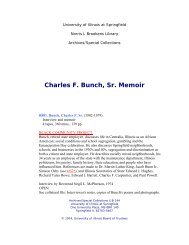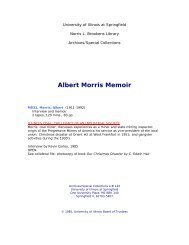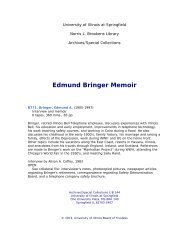<strong>Gerald</strong> W. <strong>Smith</strong> 220The bill as introduced contained several sections. Article 1 dealt sfically with the definitions that were necessam and the names of theboards; the definitions of a comprehensive c d t y college, thetion of a district and the definitions of the khds of dfstricts.or the act dealt solely with the State Junior College Boa,rd, authori kedthe creation of the bad, described the makeup of the bard, the qua i-fications of members, the powers and duties of the Board, the mandatethat they employ an executive officer and other mtters related to theboard, the dischaqe of it's duties in relation to the Born of HigherFducation and to the Cormunity College districts.Article 3 of the act was the one which described the type of district thatwas to become prevalent in the state system of junior colleges, as envisionedin the master plan. This dealt with the districts which at that timewere designated as Class I districts. This section of the act providedthe standards on which such a district could be created, the steps fororganizing such a district, and the procedures to be followed by the localarea and the state board and the Board of Higher Education, a matter ofthe referendum, the election of a ,oard of mteex for the district, thepowers and duties of the board and other mtters pertinent to the creationand operation of the comprehensive codty college district which wasenvisioned in the master plan as the district of the future for Illinois.Article 4 of the act dealt with the existing districts which had beenspoken of in the master plan, and these were desiwted in the act as ClassI1 districts. There was one unfortunate connotation to that, in that manyof the Class I1 districts translated Class I1 to mean second class becausethey were still sensitive to some of the differentials that existed betweenthem and the Class I districts. But at any rate, the act provided for thecontinuation of the existing districts. And interestingly enough it didone thing that I'll put in here right nay. It provided that, on August 1,1965, any or' those existing districts which already had a separate taxrate for educational and building f'unds were to be reorganized inmediatelyas separate districts f'rom the school district of which they weye tbm apart. Namely the board of education of such a district should on Augpst 1,constitute itself as a separate board for the Class 11 junior collegeIdistrict. So they became a part of the system of higher education by theprocess bf having the board of education constitute itself a new and eparateand different board. There were also provisions in the act that dealtwith those existi= junior colleges in school districts for which noseparate taxatidn had yet been authorlzed. I'll speak to that later n.The act went on to desc~ibe the procedures by which these districts w reto continue to operate and then there were related in this section somatters that were covered in Article 2 dealing with the state board, theprocedwes by which such districts could be converted under certain c r-cumstances k.om Class I1 to Class I. I will describe these in detail at alater point in this mative.-,Q. Just to help the listener get aebetter perspective: how 10% did ittake approxirrately to convert all of the Class I1 districts (second classdistricts) into first cdass districts?- * - -- I
<strong>Gerald</strong> W. <strong>Smith</strong> 221A. The principal project was finished in about a year and a half. Hgwever,the last Class I1 district went out of existence on June 30, 1969.So, it really didn't take long at all. For the most part, other thanthat one district which had certain problems, it had been accomplishein two years. It went rapidly.Q. So that all of the dfscussion and argunentation and negotiating wascertainly well worth while.A. Oh yes, I'm sure that the act itself dealt, with this matter in mchsharper terms and in much clemr terms than it would have, had we nothad all that dialog in that year and a half period prior to the passageof the act.Article 5 of the act dealt with capital funding. This was the new sectionthat had to be written, that dealt with the procedures for funding the actand set forth all of the procedural matters that were necessary, as wellas the standards that were necessaq for the district to qualify for the75 percent state f'unding. Interestingly enough, although the act didin a short statement provide for the possibility of the direct appropriationby the General Assembly, 98 percent of the language had to do withping through the Illinois Bulkling Authority, so it was clear that thatwas to be the route.Article 7 of the act dealt with districts lying in cities over 500,000,whlch obviously is Chicago.Article 8 was a catch-all section that dealt primavlily with the substmtiationof actions taken with regmd to junior colleges in previous law, andthe severability clause in the act which provided that any single sectionof this act was found to be unconstitutional it had no bearing on any otheract. This was the outline of the act. The bill was introduced, I've forgottenthe exact date, but it was getting up tow& May of 1965 when thebfll was introduced. It moved through the House rapidly and passed withouta dissenting vote. It was sent over to the Senate. During the periodof time in which the bill was in the House and was being discussed, it wasthe subject of detailed study by members of the School Problems Corrrmi$sion,leaders in the General Assembly, by the Illinois Association of Junio!College officials, by representatives of every single jdor college istrictin the $tat@, by the Board of Higher Education staff, and such statew deorganizations as were taking an active part at that time in the support ofthe idea of the legislation, such as the Chamber of Commerce, the Leagueof Women Voters, the Illinois Agricultural Association, and so forth.Q. How much time did you yourself devote to these hearings, and to attendingand doing things related to this process, Gerry?A. 1 spent a considerable amount of time. I no longer have a log of it,but I would say that during the months of February, Mch, and April,-Iprobably worked somewhat with the issues thah were before us at some timeduring the day, every day. I attended, of course, a significant nu&meetings of the Administrators Association, the Junior College Rssocarepresentatives of the School Evloblems Conmission, and so forth. Gnctr of;ion,: the
- Page 1 and 2: University of Illinois at Springfie
- Page 3 and 4: Gerald W. Smith 201A. I would like
- Page 5 and 6: Gerald W. Mth 20 3One of the outcom
- Page 7 and 8: Gerald W. Smith 20514-Ipeople who h
- Page 9 and 10: Gerald W. Wth 207Master Plan and th
- Page 11 and 12: Gerald W.Smithof them have retired.
- Page 13 and 14: Gerald W. Smith 211Q. There was lot
- Page 15 and 16: Gerald W. Sr~Lth 2131As a counte~pr
- Page 17 and 18: Gerald W. Smith215IWge tuition at o
- Page 19 and 20: Gerald W.SmithA. And m n I'll speak
- Page 21: Gerald W. Smith 219to continue with
- Page 25 and 26: Gerald W.SmithQ. And who was it tha
- Page 27 and 28: Gerald W. SMth 225who was skilled o
- Page 29 and 30: Gerald W. Smith 227A. Generally spe
- Page 31 and 32: Gerald W. mth 2 29climate fop it. B
- Page 33 and 34: Gerald W. Smith 2 31discuss this as
- Page 35 and 36: Gerald W. Smith 2 3Education; I'm t
- Page 37 and 38: Gerald W.Smlth23Fjbut we would say
- Page 39 and 40: Gerald W. Smith 237point out that i
- Page 41 and 42: For example, when they met on the a
- Page 43 and 44: Gerald W. Smith 241Hawk Cammity Col
- Page 45 and 46: Gerald W. Smith 243was there wlth a
- Page 47 and 48: Gerald W. Smith 245The following is
- Page 49 and 50: 1people who were working wfth me a
- Page 51 and 52: Gerald W. Smith 249I was looking in
- Page 53 and 54: Gerald W. Smith 251.developnents ea
- Page 55 and 56: Gerald W. Smith 253Secretm for the
- Page 57 and 58: Gerald W. Smith 255He and I then wo
- Page 59 and 60: Gerald W. Smith 257One of the peopl
- Page 61 and 62: Gerald W.Smith259we always indicate
- Page 63 and 64: Gerald W. Smith26rCentralia, 1940;M
- Page 65 and 66: Gerald W.SmithJdor College Act ax i
- Page 67 and 68: Gerald W. Smith 265districts, also
- Page 69 and 70: Gerald W. Smith 267A. Yes, I think
- Page 71 and 72: Q. That's an unbelievable record.A.
- Page 73 and 74:
So this is the story of Danville. I
- Page 75 and 76:
Gerald W. Smith 2 73Of course, you
- Page 77 and 78:
At the far south, a junlor college
- Page 79 and 80:
Gerald W. Smith 2 77FIe ad, In fact
- Page 81 and 82:
me, but he was not happy about it t
- Page 83 and 84:
Gerald W. Smith 281Q. Let me ask ya
- Page 85 and 86:
not understanding the le@slative pr
- Page 87 and 88:
Gerald W. Mth 2 85I tbhk it 2s inte
- Page 89 and 90:
Gerald W. Smith 287Board received a
- Page 91 and 92:
Gerald W. Smith 2 89land they were
- Page 93 and 94:
Gerald W. Smith 291Q. Now there was
- Page 95 and 96:
Q. Was there sane particular reason
- Page 97 and 98:
At any rate, it was a year before t
- Page 99 and 100:
A. Yes. He was the prbe mver and le
- Page 101 and 102:
Gerald W. Smith 9opportunity to org
- Page 103 and 104:
Gerald W. Wth 30 1of Cook County is
- Page 105 and 106:
A. ... even though the statutes pre
- Page 107 and 108:
Gerald W. Wth 30 5who actually, as
- Page 109 and 110:
Gerald W. Smith 30 7Their feasibili
- Page 111 and 112:
Gerald W.Wth309There were two quota
- Page 113 and 114:
Gerald W, Smith. -The referendum fo
- Page 115 and 116:
Gerald W. Smith 31 3In the Galesbur
- Page 117 and 118:
Gerald W.Smith315Q. This is perhaps
- Page 119 and 120:
Gerald W. Smith 317proposal - just
- Page 121 and 122:
Gerald W. Smith 319I would poht out
- Page 123 and 124:
Gerald W.Smith321$0 they were to go
- Page 125 and 126:
They enunciated a pollcy that was n
- Page 127 and 128:
Gerald FI, Wth325A. I have never se
- Page 129 and 130:
Gerald W. Wth 32 7A. Yes, the count
- Page 131 and 132:
Gemld W. Smith 329A. Well, yes, I a
- Page 133 and 134:
Q. This is a continuation of the in
- Page 135 and 136:
Gerald W. Smith 333were workin@; to
- Page 137 and 138:
Gerald W. Smith 335perhaps to take
- Page 139 and 140:
Gerald W. Smith 337'Rut north in Un
- Page 141 and 142:
Gerald W. Smith 339A. Speaking now
- Page 143 and 144:
Gerald W. Smith 341A. Well they are
- Page 145 and 146:
Gerald W. Smith 343opportunity to d
- Page 147 and 148:
Gerald W. Smith 341This district wa
- Page 149 and 150:
Gerald W. Smith 34 7When Cahokia pe
- Page 151 and 152:
Gerald W. Smith 349Q. This is tape





